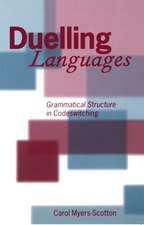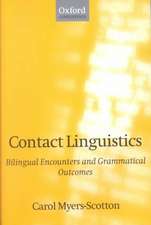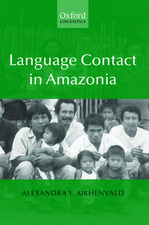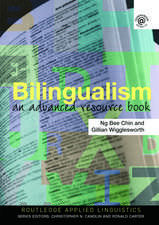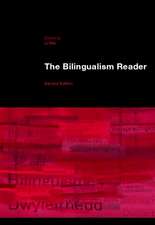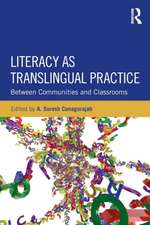The Use of First and Second Language in Chinese University EFL Classrooms
Autor Yi Duen Limba Engleză Hardback – 31 aug 2016
| Toate formatele și edițiile | Preț | Express |
|---|---|---|
| Paperback (1) | 387.20 lei 6-8 săpt. | |
| Springer Nature Singapore – 21 apr 2018 | 387.20 lei 6-8 săpt. | |
| Hardback (1) | 394.51 lei 6-8 săpt. | |
| Springer Nature Singapore – 31 aug 2016 | 394.51 lei 6-8 săpt. |
Preț: 394.51 lei
Nou
Puncte Express: 592
Preț estimativ în valută:
75.50€ • 77.89$ • 63.90£
75.50€ • 77.89$ • 63.90£
Carte tipărită la comandă
Livrare economică 04-18 martie
Preluare comenzi: 021 569.72.76
Specificații
ISBN-13: 9789811019104
ISBN-10: 981101910X
Pagini: 276
Ilustrații: XII, 264 p. 11 illus., 2 illus. in color.
Dimensiuni: 155 x 235 x 18 mm
Greutate: 0.57 kg
Ediția:1st ed. 2016
Editura: Springer Nature Singapore
Colecția Springer
Locul publicării:Singapore, Singapore
ISBN-10: 981101910X
Pagini: 276
Ilustrații: XII, 264 p. 11 illus., 2 illus. in color.
Dimensiuni: 155 x 235 x 18 mm
Greutate: 0.57 kg
Ediția:1st ed. 2016
Editura: Springer Nature Singapore
Colecția Springer
Locul publicării:Singapore, Singapore
Cuprins
Foreword.- Acknowledgements.- Table of Contents.- List of Tables.- List of Figures.- Chapter 1 Introduction.- Section A Background and Design.- Chapter 2 The L1 in L2 learning and teaching.- Chapter 3 Code-switching.- Chapter 4 Research Design.- Section B Results.- Chapter 5 Classroom Data.- Chapter 6 Interviews.- Chapter 7 Stimulated Recall.- Section C Conclusions.- Chapter 8 Discussion and Conclusions.- Bibliography.- Appendices(Introductory Note).- Appendix 1: Sample Analysis of Code-Switching Instances (Carl).- Appendix 2: Sample Pre- and Post-Observation Interview (Anne).
Notă biografică
Dr. Yi Du is a lecturer in the English department at North China Electric Power University. She holds a PhD in Applied Language Studies from the University of Edinburgh, UK. Her research interests include code-switching, classroom discourse, teachers’ beliefs and teacher education.
Textul de pe ultima copertă
This book investigates first language (L1) and second language (L2) use in Chinese university classrooms, focusing on the experiences of four Chinese EFL teachers who were teaching non-English major students at four different proficiency levels. It examines these four teachers' actual use of L1 and L2, including the distribution of their L1 and L2 use; the circumstances, functions and grammatical patterns of their language use; and their language use across different frames of classroom discourse. It also explores their attitudes and beliefs regarding this issue in depth, as well as their own perceptions of and reasons for their language use and possible influencing factors. Through its detailed analysis of the teachers' language use, as well as their respective beliefs and decision-making techniques, this book contributes to L2 teachers' professional development and L2 teaching in general, especially with regard to establishing a pedagogically principled approach to L1 and L2 use.
Caracteristici
Reviews literature on classroom language use from both an applied linguistic and a sociolinguistic perspective Provides readers with an excellent overview of the topic Features figures and illustrations that paint a clear picture of the observed teachers' L1 and L2 use, including their common ground and differences Includes supplementary material: sn.pub/extras

